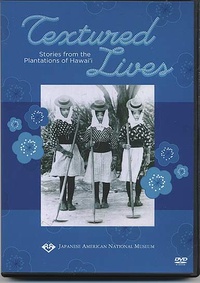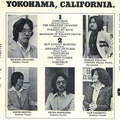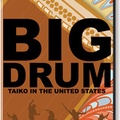Last August (2010), during the Obon holiday, it was in the sweltering heat of Tokyo that I saw this documentary film for the very first time. My friend, Shin Miyata (representing Music Camp), organized the screening and invited the film’s producer/director, Akira Boch, from Los Angeles for the event. After a modest introduction by Mr. Boch, the film began with an image of Japanese workers on a sugarcane plantation, coupled with a voiceover by Barbara Kawakami, who is the main character of this story. The film was off to a promising start.
However, in the very next scene, I let out a gasp as I saw an old photograph appear on the screen. It was a picture of the retail store that my great grandfather owned, where my grandmother (who passed away two years ago, at age 100) had been born! It was in the village along the main street, below the sugar mill. Back then, the Japanese immigrants used to call the area “Waipahu Honchou”. My eyes were immediately glued to the screen.

Great grandfather's retail store Kato Shoten (Genkinya). It was the largest retail store in Waipahu at that time. (Photo courtesy of Minoru Kanda)
Barbara Kawakami was born in Kumamoto prefecture and raised in Waipahu. Drawn to the mix of kimonos and western clothing worn by the Issei women, she became interested in dressmaking at a young age and aspired to become a clothing designer. After graduating school, she experienced racial discrimination while working as a housemaid. Then she attended tailoring school to study dressmaking, and went on to open her very own dressmaking store in her hometown. Her business attracted a nice client base, including the wives of Caucasian military men, and her business seemed to be doing well. However, she would soon realize that although she had the technical skills as a tailor, she lacked the proper education.
After marriage, childbirth, and motherhood, she decided to enter community college when her son left for the mainland to attend college himself. As a result of furious studying, she obtained a Bachelor of Science in Textile & Clothing, and a Master of Arts in Asian Studies at the University of Hawai’i at Manoa. Encouraged by her professor, she would go on to author “Japanese Immigrant Clothing in Hawaii 1885-1941” (Heibonsha Publishers, Ltd.), a publication concerning a mixture of sociology, anthropology, and history.
Barbara’s greatest strength lies in the fact that she is a technically skilled dressmaker and also a designer at the same time. With expertise and knowledge gained over many years of experience and from bearing witness to a generation herself, Barbara possesses a sense of authority that cannot be equaled by simply studying information gathered from books. Coupled with how impressive the richness of the kimono culture is in Hawaii, there is no doubt that Barbara’s work has been extremely valuable to the Japanese community.
Barbara’s contributions go beyond the garment industry. Born in Kumamoto prefecture, she is fluent in Japanese; in addition, she has an uncanny ability to understand all kinds of dialects that were spoken on the plantations—a skill she used in order to interview several Issei. I assume her interview skills were also impressive—instead of the typical “timid researcher asking abstract questions,” she must have asked pointed questions about the type of clothing they used to wear—questions about what their work uniforms were like, or about their day-to-day clothing, or what they wore for festivals or special occasions… And I believe this is the reason why even the particularly tight-lipped “Picture Brides” were prompted to reveal their experiences—stories that they had never even told their own family members—to Barbara. This marks a very important point.
Personally, I have worked similarly on a publication about my Issei great-grandfather, his son, and his daughter (my grandmother), operating a large retail store, also in Waipahu. During my research, I discovered how difficult it was to trace back the history without losing focus—it was hard enough just trying to string all of the memories together. I couldn’t help but fall short on the specifics.
On the other hand, Barbara specializes in garments—one of the three basic human necessities of “clothing, food, and housing”. Clothing is at the core of our daily lives. By starting with a specific question—“What do you remember wearing?”—Barbara had broken through to the Issei generation to unravel their memories. In other words, she started with the undividable relationship between people and clothing, and continued on to reveal the history of immigration and the cultural history of Nikkei Hawaiian Americans. This type of work is rarely born from the academic world.
This film is an autobiography of a Nikkei woman named Barbara Kawakami, and at the same time it also serves as the history of the second largest Japanese community at the time in Oahu behind Honolulu—the cultural history of the sugar plantation village of Waipahu. Although I was born in Japan, as a person who is closely linked to Waipahu, I feel like I’ve stumbled upon a wonderful treasure.
Lastly, I would like to give my appreciation to the producer/director, Akira Boch, for the care put into making this film. There is no forcefulness in trying to create a “Hawaiian feel” in the visuals, and I found Barbara’s soothing narration—which drives the overall tempo of the film—to be the most brilliant aspect of this film. The special features included in the DVD are wonderfully moving as well—but I suppose those wouldn’t require any extra analysis on my part.
© 2011 Minoru Kanda






